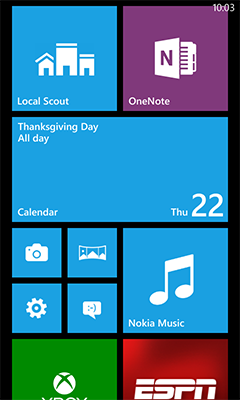Windows Phone 8
Windows Phone 8 is the second generation of the Windows Phone mobile operating system developed by Microsoft. It was officially released on October 29, 2012, and succeeded Windows Phone 7. Windows Phone 8 introduced a number of new features and improvements over its predecessor, including a new kernel, support for multi-core processors, and a more customizable Start screen.
Features[edit | edit source]
Kernel[edit | edit source]
Windows Phone 8 is based on the Windows NT kernel, which is the same kernel used in Windows 8 and Windows 10. This change allowed for better performance, improved security, and greater hardware compatibility.
Start Screen[edit | edit source]
The Start screen in Windows Phone 8 is highly customizable, allowing users to resize Live Tiles and arrange them according to their preferences. This feature provides a more personalized user experience.
Multi-core Processor Support[edit | edit source]
Windows Phone 8 introduced support for multi-core processors, which significantly improved the performance and responsiveness of the operating system. This was a major upgrade from Windows Phone 7, which only supported single-core processors.
Internet Explorer 10[edit | edit source]
Windows Phone 8 comes with Internet Explorer 10, which offers improved performance, better support for HTML5, and enhanced security features.
Wallet[edit | edit source]
The Wallet feature in Windows Phone 8 allows users to store debit, credit, loyalty, and membership card information. It also supports NFC payments, making it easier for users to make transactions using their phones.
Maps[edit | edit source]
Windows Phone 8 includes a new mapping service powered by Bing Maps and Nokia Maps, providing users with improved navigation and location services.
Backup and Restore[edit | edit source]
The operating system offers comprehensive backup and restore options, allowing users to back up their app data, settings, and text messages to the cloud.
Kid's Corner[edit | edit source]
Kid's Corner is a feature that allows parents to create a separate, restricted environment for their children to use. This ensures that children can only access age-appropriate content and apps.
Hardware Requirements[edit | edit source]
Windows Phone 8 has specific hardware requirements, including support for multi-core processors, a minimum of 512 MB of RAM, and at least 4 GB of internal storage. The operating system also supports higher screen resolutions, including WXGA (1280x768) and 720p (1280x720).
Updates[edit | edit source]
Windows Phone 8 received several updates during its lifecycle, with the most notable being the Windows Phone 8.1 update, which introduced further enhancements and new features. The final update for Windows Phone 8 was version 8.10.14234.375, released on November 13, 2014.
Discontinuation[edit | edit source]
Windows Phone 8 was succeeded by Windows Phone 8.1 in April 2014. Microsoft eventually discontinued the Windows Phone platform in favor of Windows 10 Mobile, which aimed to unify the Windows experience across all device types.
See Also[edit | edit source]
- Windows Phone
- Windows Phone 7
- Windows Phone 8.1
- Windows 10 Mobile
- Microsoft Lumia
- Metro (design language)
References[edit | edit source]
External Links[edit | edit source]
Navigation: Wellness - Encyclopedia - Health topics - Disease Index - Drugs - World Directory - Gray's Anatomy - Keto diet - Recipes
Search WikiMD
Ad.Tired of being Overweight? Try W8MD's physician weight loss program.
Semaglutide (Ozempic / Wegovy and Tirzepatide (Mounjaro / Zepbound) available.
Advertise on WikiMD
WikiMD is not a substitute for professional medical advice. See full disclaimer.
Credits:Most images are courtesy of Wikimedia commons, and templates Wikipedia, licensed under CC BY SA or similar.Contributors: Prab R. Tumpati, MD

